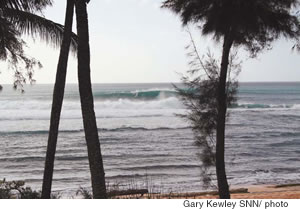Surf Numbers

Friday - February 24, 2006
| Share
 Del.icio.us
Del.icio.us
An 8-10 Hawaii Scale foot set at Sunset Beach
Aloha, surfers and beachgoers! As we head toward the end of the month, we can clearly see that February surf heights are way below average. There are a few factors that have contributed to this. One is the overall La Nina winter: the unusually cold ocean temperatures in the equatorial Pacific (El Nino is unusually warm temps near the equator). A second factor is this temporary large high pressure system sitting right where we don’t want it or just above us ... It’s been hanging around a long time. This competes with storms or low pressure systems that send us the big waves. The last thing is the jet stream, or strong mass of airflows high in the troposphere ... typically east to west ... in the mid-latitudes. The “jet” has been broken up for some time, and this stops the optimal track of our surf-maker storms off Japan. The good news is that these things can and do change. In fact, we are likely to see the jet stream come back together in March and the high pressure move or mellow out. So March can still deliver big waves! But don’t overlook another big factor ... we surfers must face the fact that March says we are zooming toward spring. The big guns and tow-in material will soon gather summer dust.
If you missed last week, I had a wonderful interview with “da man” many surfers call the modern-day surf forecast guru, Pat Caldwell. He’s Hawaii’s NOAA Data Centers liaison. For us wave riders, he’s “the keeper of surf numbers” ... and he can crunch them, too! We spoke about the scientifically valid Hawaii Scale for determining wave heights, other coastal concerns and their effects on us. He was recently published in the Journal of Coastal Research.
GQ: So, continuing on ... Our Hawaii Scale Feet is the scale used for the record books nearly four decades now?
PAT: Right. Thanks to the combined efforts with Larry Goddard we have data back to early 1968.
GQ: And, it’s been consistent over decades ... so this reflects well on the quality of observations that surfers have given?
PAT:Yes, and that was the second aspect to it ... the results are in “coarse resolution,” which means that there are error bars of, say, 10 to 20 percent or a few feet (broader increments than just one foot) ... and they increase as the surf increases. But since the range of surf on the North Shore is so large, say, from 0 to 40 feet ... the error bars are not really that big. We can certainly use it to bracket the data in, say, small, medium, large, extra large, giant ... this is very important. There’s enough resolution to help with coastal erosion studies, safety, etc.
GQ: What does this say for Hawaii surfers?
PAT: It’s critical because it says that the Hawaii Scale has historical context. It means that an experienced surfer who shows up on the North Shore when it’s big has watched, for years, hundreds of swells ... they can use indicators for overall energy and size. They know how to compare relative wave energy from one day to another. Based on established factors such as rip currents, where are the waves breaking along a given reef? Are the outer reefs breaking? What’s the beach run up? And they are consistent over a large amount of time.
GQ: Of course ...
PAT: Sort of like a holistic doctor who doesn’t just look at your wound, but looks at the whole body to understand the situation. This is what the local surfers are doing ... giving a comprehensive view.
GQ:And these benchmarks are tied into the Hawaii Scale?
PAT: Right, it refers to the surf energy in the ocean ... not the particular height on a particular wave. It could be likened to the power of rapids in a river ... it may go from a category 1 to a category 5.
GQ: Cool ... Thank you Pat, for more of the great insights.
So, what about face value?
Well, that’s a subject for next week because it’s way too important to begin now with limited space. No worries ... it’s all good.
Hey, the T&C Surf/Tony Volkswagen Women’s Pipeline Pro is coming up March 1-14. Be here next weekend when I speak with contest director Betty Depolito. Also, the Fosters ASP World Tour kicks off Down Under on Australia’s Gold Coast Feb. 28-March 12. Log onto SURFNEWSNETWORK.COM to get your juicy details. March is going to rock, and so will you and I in MidWeek! Can’t wait to have you here again!
GQ, dropping in 4 U!
E-mail this story | Print this page | Comments (0) | Archive | RSS Comments (0) |
Most Recent Comment(s):













